Deakin University: Foreign Aid's Economic Effects on Healthcare
VerifiedAdded on 2023/06/12
|9
|2527
|196
Essay
AI Summary
This essay examines the multifaceted impact of foreign aid on the health sectors of low and middle-income countries, considering both its potential benefits and drawbacks. It begins by defining foreign aid for health, highlighting its importance in addressing healthcare needs in countries where out-of-pocket expenses often create a significant barrier to access. The essay then presents examples of positive outcomes, such as improved child mortality rates in Ethiopia and healthcare enhancements in Afghanistan and South Sudan, achieved through targeted aid programs. Conversely, it also explores negative consequences, including the substitution effect in Tanzania, debt burdens in Pakistan, and wealth disparities exacerbated by corruption in Kenya. The essay concludes by discussing policy approaches to mitigate the distortionary effects of health aid, such as promoting local ownership, preventing donor self-interest, combating corruption, fostering democratic reforms, and ensuring equitable aid allocation. It emphasizes that the effectiveness of foreign aid hinges on responsible utilization by recipient countries and the elimination of colonial undertones from donor requirements. Desklib offers a platform for students to access similar essays and study resources.
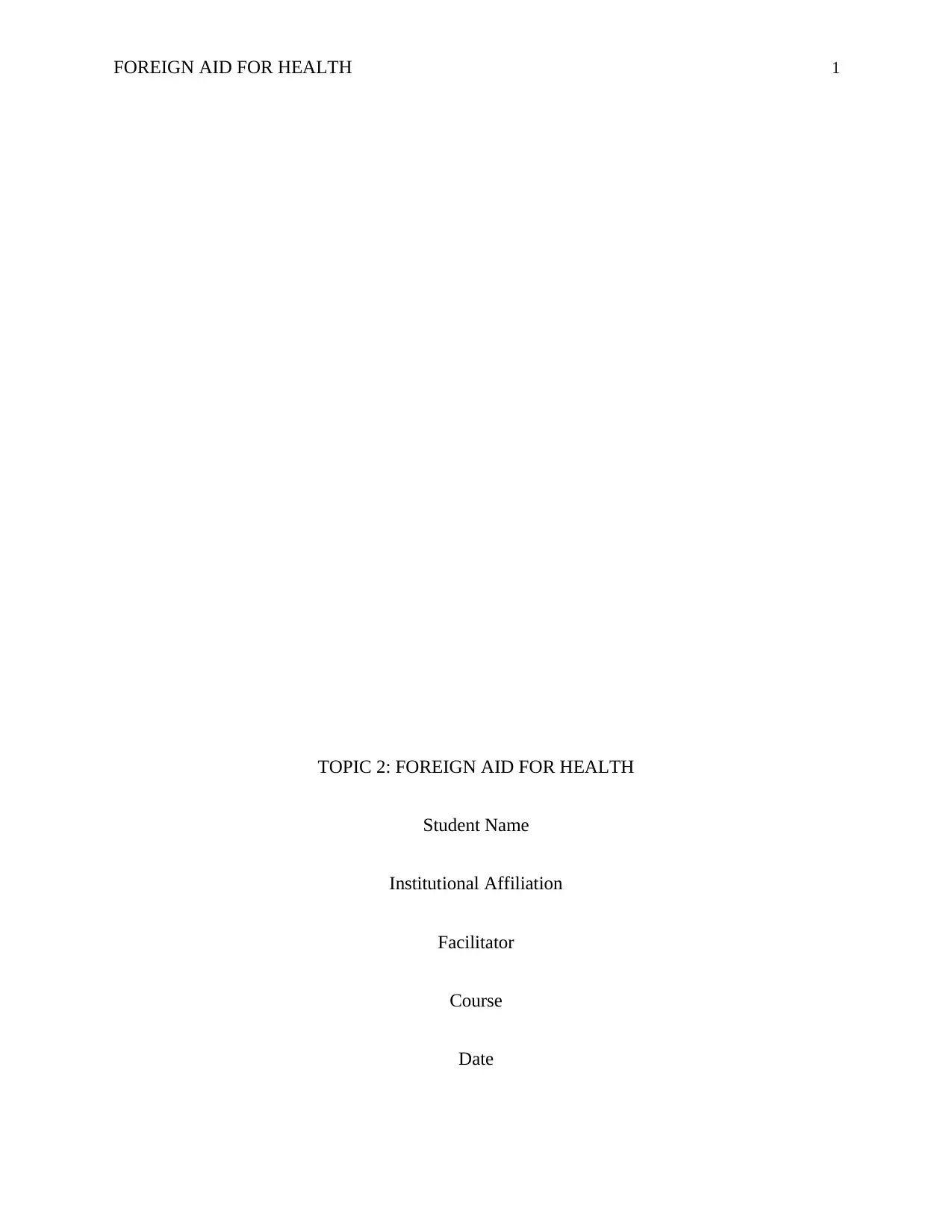
FOREIGN AID FOR HEALTH 1
TOPIC 2: FOREIGN AID FOR HEALTH
Student Name
Institutional Affiliation
Facilitator
Course
Date
TOPIC 2: FOREIGN AID FOR HEALTH
Student Name
Institutional Affiliation
Facilitator
Course
Date
Paraphrase This Document
Need a fresh take? Get an instant paraphrase of this document with our AI Paraphraser
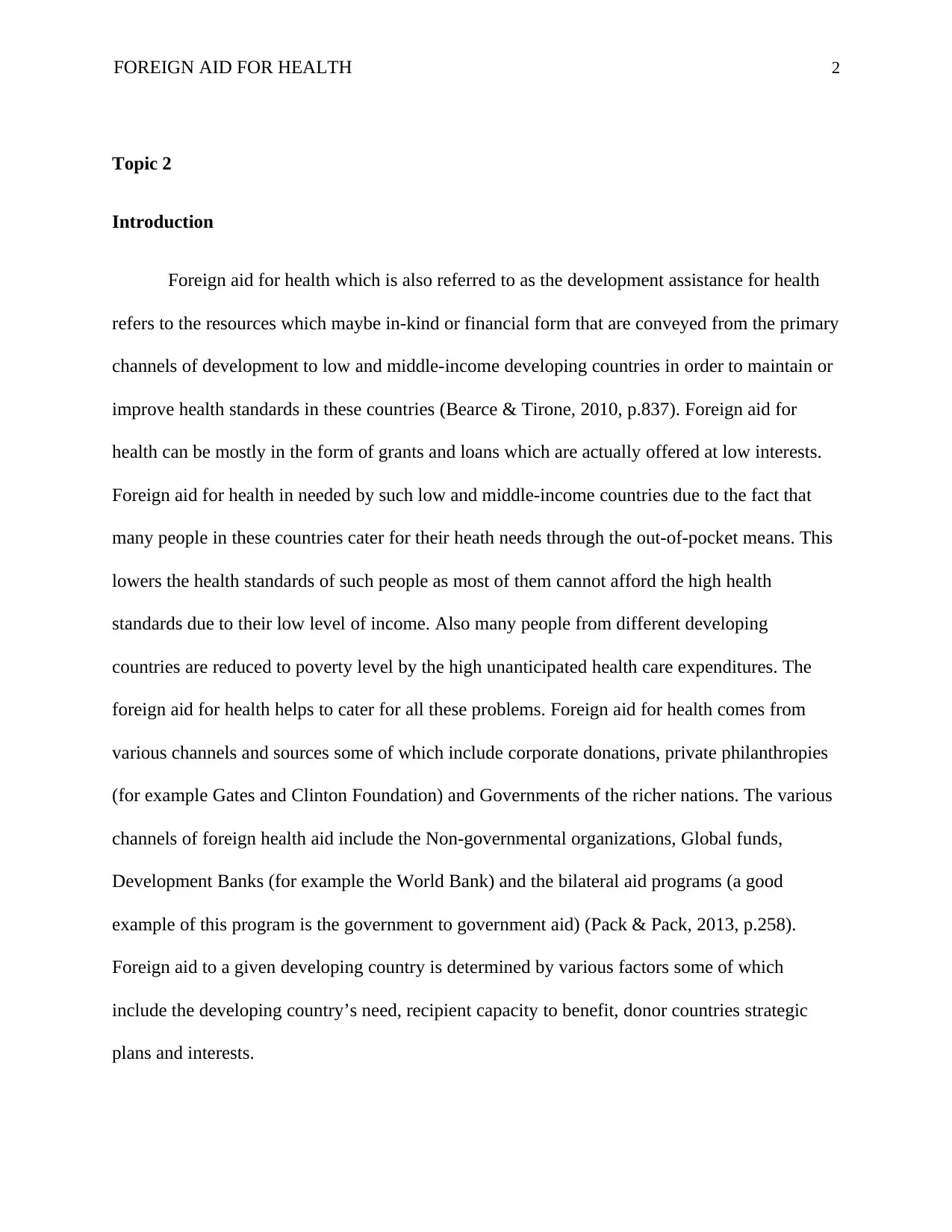
FOREIGN AID FOR HEALTH 2
Topic 2
Introduction
Foreign aid for health which is also referred to as the development assistance for health
refers to the resources which maybe in-kind or financial form that are conveyed from the primary
channels of development to low and middle-income developing countries in order to maintain or
improve health standards in these countries (Bearce & Tirone, 2010, p.837). Foreign aid for
health can be mostly in the form of grants and loans which are actually offered at low interests.
Foreign aid for health in needed by such low and middle-income countries due to the fact that
many people in these countries cater for their heath needs through the out-of-pocket means. This
lowers the health standards of such people as most of them cannot afford the high health
standards due to their low level of income. Also many people from different developing
countries are reduced to poverty level by the high unanticipated health care expenditures. The
foreign aid for health helps to cater for all these problems. Foreign aid for health comes from
various channels and sources some of which include corporate donations, private philanthropies
(for example Gates and Clinton Foundation) and Governments of the richer nations. The various
channels of foreign health aid include the Non-governmental organizations, Global funds,
Development Banks (for example the World Bank) and the bilateral aid programs (a good
example of this program is the government to government aid) (Pack & Pack, 2013, p.258).
Foreign aid to a given developing country is determined by various factors some of which
include the developing country’s need, recipient capacity to benefit, donor countries strategic
plans and interests.
Topic 2
Introduction
Foreign aid for health which is also referred to as the development assistance for health
refers to the resources which maybe in-kind or financial form that are conveyed from the primary
channels of development to low and middle-income developing countries in order to maintain or
improve health standards in these countries (Bearce & Tirone, 2010, p.837). Foreign aid for
health can be mostly in the form of grants and loans which are actually offered at low interests.
Foreign aid for health in needed by such low and middle-income countries due to the fact that
many people in these countries cater for their heath needs through the out-of-pocket means. This
lowers the health standards of such people as most of them cannot afford the high health
standards due to their low level of income. Also many people from different developing
countries are reduced to poverty level by the high unanticipated health care expenditures. The
foreign aid for health helps to cater for all these problems. Foreign aid for health comes from
various channels and sources some of which include corporate donations, private philanthropies
(for example Gates and Clinton Foundation) and Governments of the richer nations. The various
channels of foreign health aid include the Non-governmental organizations, Global funds,
Development Banks (for example the World Bank) and the bilateral aid programs (a good
example of this program is the government to government aid) (Pack & Pack, 2013, p.258).
Foreign aid to a given developing country is determined by various factors some of which
include the developing country’s need, recipient capacity to benefit, donor countries strategic
plans and interests.
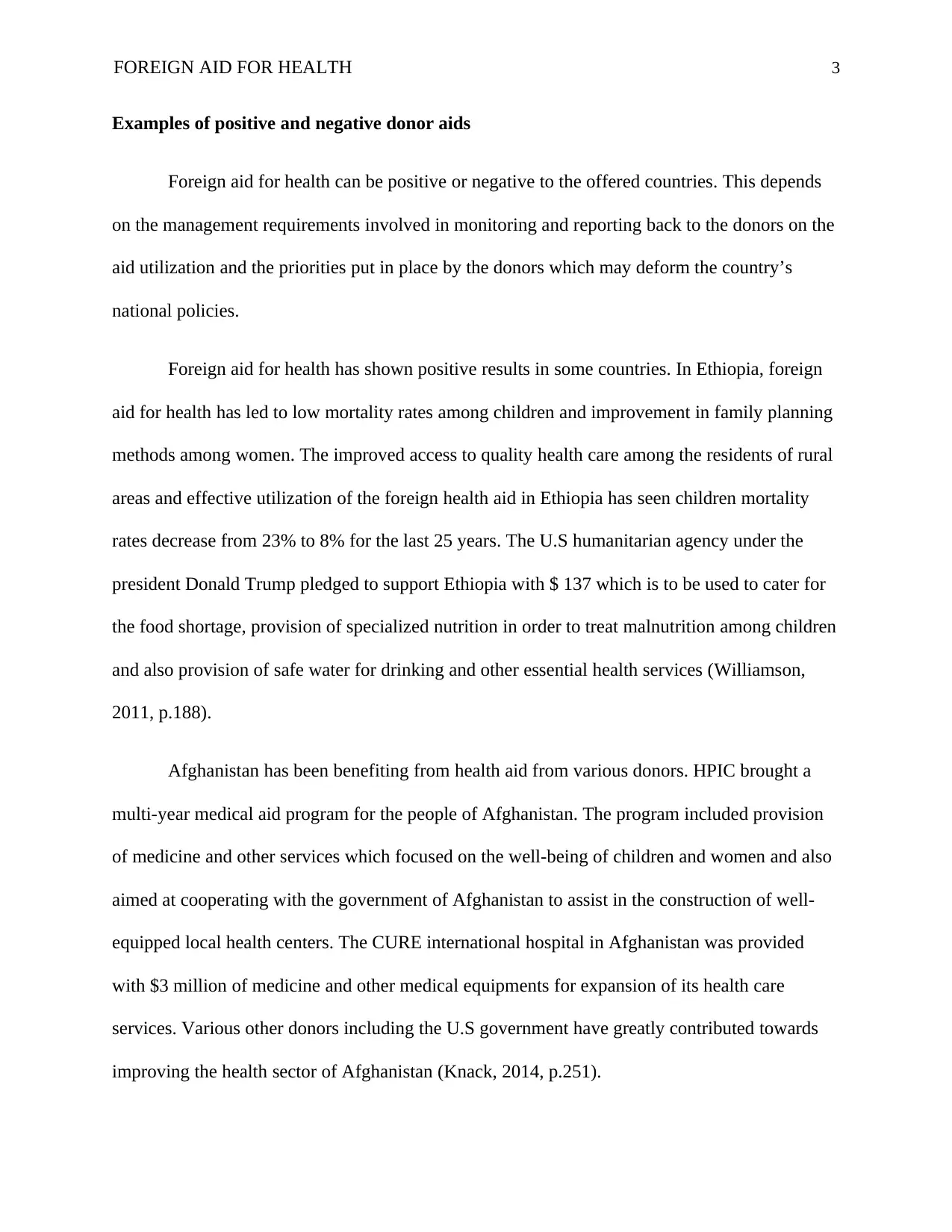
FOREIGN AID FOR HEALTH 3
Examples of positive and negative donor aids
Foreign aid for health can be positive or negative to the offered countries. This depends
on the management requirements involved in monitoring and reporting back to the donors on the
aid utilization and the priorities put in place by the donors which may deform the country’s
national policies.
Foreign aid for health has shown positive results in some countries. In Ethiopia, foreign
aid for health has led to low mortality rates among children and improvement in family planning
methods among women. The improved access to quality health care among the residents of rural
areas and effective utilization of the foreign health aid in Ethiopia has seen children mortality
rates decrease from 23% to 8% for the last 25 years. The U.S humanitarian agency under the
president Donald Trump pledged to support Ethiopia with $ 137 which is to be used to cater for
the food shortage, provision of specialized nutrition in order to treat malnutrition among children
and also provision of safe water for drinking and other essential health services (Williamson,
2011, p.188).
Afghanistan has been benefiting from health aid from various donors. HPIC brought a
multi-year medical aid program for the people of Afghanistan. The program included provision
of medicine and other services which focused on the well-being of children and women and also
aimed at cooperating with the government of Afghanistan to assist in the construction of well-
equipped local health centers. The CURE international hospital in Afghanistan was provided
with $3 million of medicine and other medical equipments for expansion of its health care
services. Various other donors including the U.S government have greatly contributed towards
improving the health sector of Afghanistan (Knack, 2014, p.251).
Examples of positive and negative donor aids
Foreign aid for health can be positive or negative to the offered countries. This depends
on the management requirements involved in monitoring and reporting back to the donors on the
aid utilization and the priorities put in place by the donors which may deform the country’s
national policies.
Foreign aid for health has shown positive results in some countries. In Ethiopia, foreign
aid for health has led to low mortality rates among children and improvement in family planning
methods among women. The improved access to quality health care among the residents of rural
areas and effective utilization of the foreign health aid in Ethiopia has seen children mortality
rates decrease from 23% to 8% for the last 25 years. The U.S humanitarian agency under the
president Donald Trump pledged to support Ethiopia with $ 137 which is to be used to cater for
the food shortage, provision of specialized nutrition in order to treat malnutrition among children
and also provision of safe water for drinking and other essential health services (Williamson,
2011, p.188).
Afghanistan has been benefiting from health aid from various donors. HPIC brought a
multi-year medical aid program for the people of Afghanistan. The program included provision
of medicine and other services which focused on the well-being of children and women and also
aimed at cooperating with the government of Afghanistan to assist in the construction of well-
equipped local health centers. The CURE international hospital in Afghanistan was provided
with $3 million of medicine and other medical equipments for expansion of its health care
services. Various other donors including the U.S government have greatly contributed towards
improving the health sector of Afghanistan (Knack, 2014, p.251).
⊘ This is a preview!⊘
Do you want full access?
Subscribe today to unlock all pages.

Trusted by 1+ million students worldwide

FOREIGN AID FOR HEALTH 4
The International Organization for Migration (IOM) has been constantly providing health
care to the people of South-Sudan. South-Sudan residents suffered from many diseases and
malnutrition due to insecurity and the fact that they could not be reached out as they flea for their
safety due to insecurity (Wilson, S.E., 2011, p.2032). IOM reached them in their remote areas
and set up a clinic for them. The organization also provided the people with shelter and
continued to build more health facilities in the remote areas to help those who travelled for
longer distances to reach out the clinics. The organization also conducted water sanitation and
the repairing of boreholes and also formed water management committees in order to provide
clean water to the people residing in the remote areas of South-Sudan (Svensson, 2010. P.61).
On the other hand foreign aid for health has led to negative results in some countries. In
fact its involvement in such countries has been more of a burden than a benefit. Tanzania which
is a country in East Africa has been receiving a lot of foreign aid since 1970s. The foreign aid for
health allocated to Tanzania does not seem to help the nation in terms of improvement both in
health standards and the economy. The aid allocated to heath sector makes the government of
Tanzania to lower the amount it allocates to the health sector and use it in other sectors of the
economy. This substitution effect highly affects the nation of Tanzania as no positive results are
realized from high amounts of aid allocated to the health sector (Atwood, Brian, Peter
McPherson & Andrew Natsios, 2011, p.123).
Pakistan has been highly relying on foreign aid for health to improve its health sector and
its entire development programs. It started by obtaining foreign aid in form of grants to reduce
fiscal strain and stir economic development. Later on the grants changed to hard loans. These
loans led to drastic rise in the tax ratio to gross domestic product of the economy and as a result
The International Organization for Migration (IOM) has been constantly providing health
care to the people of South-Sudan. South-Sudan residents suffered from many diseases and
malnutrition due to insecurity and the fact that they could not be reached out as they flea for their
safety due to insecurity (Wilson, S.E., 2011, p.2032). IOM reached them in their remote areas
and set up a clinic for them. The organization also provided the people with shelter and
continued to build more health facilities in the remote areas to help those who travelled for
longer distances to reach out the clinics. The organization also conducted water sanitation and
the repairing of boreholes and also formed water management committees in order to provide
clean water to the people residing in the remote areas of South-Sudan (Svensson, 2010. P.61).
On the other hand foreign aid for health has led to negative results in some countries. In
fact its involvement in such countries has been more of a burden than a benefit. Tanzania which
is a country in East Africa has been receiving a lot of foreign aid since 1970s. The foreign aid for
health allocated to Tanzania does not seem to help the nation in terms of improvement both in
health standards and the economy. The aid allocated to heath sector makes the government of
Tanzania to lower the amount it allocates to the health sector and use it in other sectors of the
economy. This substitution effect highly affects the nation of Tanzania as no positive results are
realized from high amounts of aid allocated to the health sector (Atwood, Brian, Peter
McPherson & Andrew Natsios, 2011, p.123).
Pakistan has been highly relying on foreign aid for health to improve its health sector and
its entire development programs. It started by obtaining foreign aid in form of grants to reduce
fiscal strain and stir economic development. Later on the grants changed to hard loans. These
loans led to drastic rise in the tax ratio to gross domestic product of the economy and as a result
Paraphrase This Document
Need a fresh take? Get an instant paraphrase of this document with our AI Paraphraser
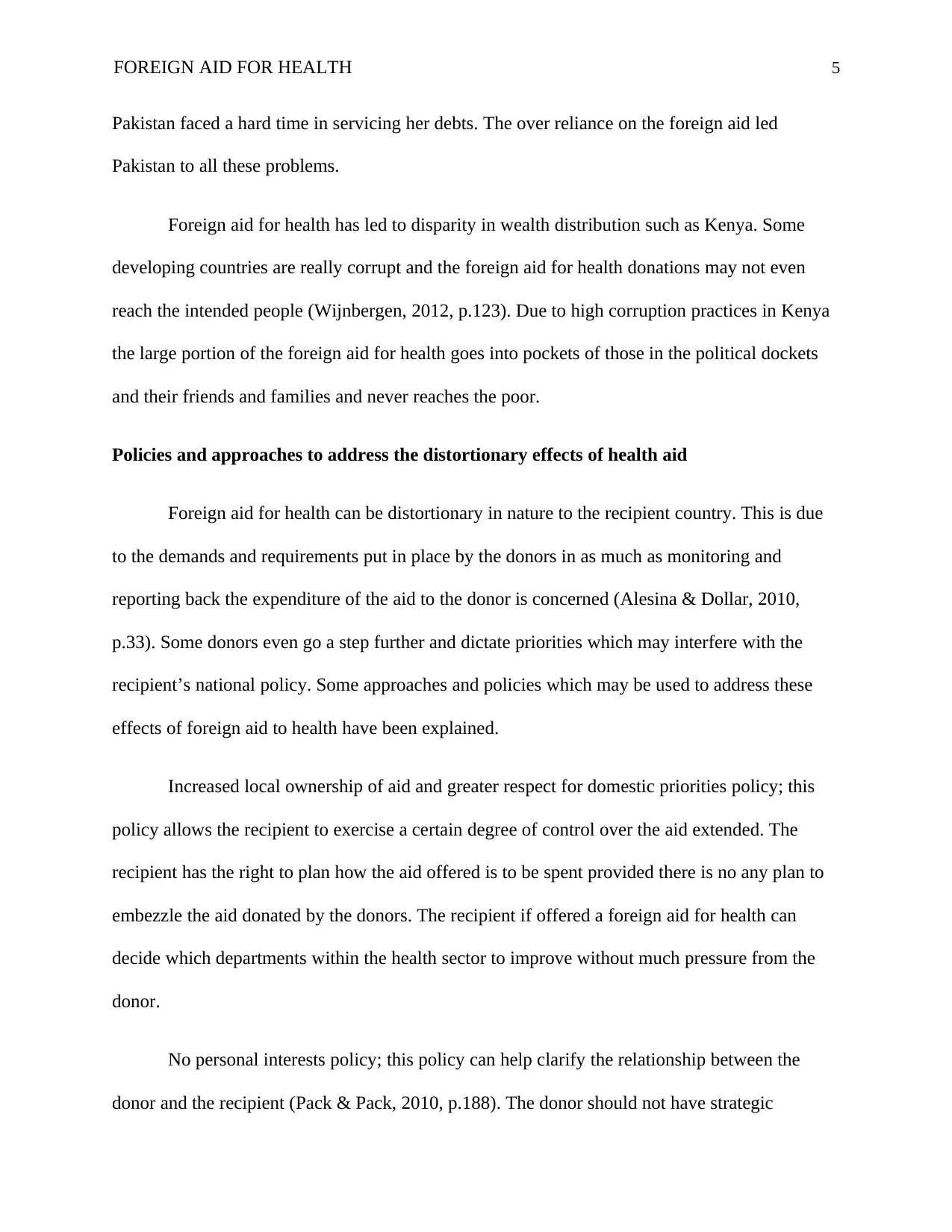
FOREIGN AID FOR HEALTH 5
Pakistan faced a hard time in servicing her debts. The over reliance on the foreign aid led
Pakistan to all these problems.
Foreign aid for health has led to disparity in wealth distribution such as Kenya. Some
developing countries are really corrupt and the foreign aid for health donations may not even
reach the intended people (Wijnbergen, 2012, p.123). Due to high corruption practices in Kenya
the large portion of the foreign aid for health goes into pockets of those in the political dockets
and their friends and families and never reaches the poor.
Policies and approaches to address the distortionary effects of health aid
Foreign aid for health can be distortionary in nature to the recipient country. This is due
to the demands and requirements put in place by the donors in as much as monitoring and
reporting back the expenditure of the aid to the donor is concerned (Alesina & Dollar, 2010,
p.33). Some donors even go a step further and dictate priorities which may interfere with the
recipient’s national policy. Some approaches and policies which may be used to address these
effects of foreign aid to health have been explained.
Increased local ownership of aid and greater respect for domestic priorities policy; this
policy allows the recipient to exercise a certain degree of control over the aid extended. The
recipient has the right to plan how the aid offered is to be spent provided there is no any plan to
embezzle the aid donated by the donors. The recipient if offered a foreign aid for health can
decide which departments within the health sector to improve without much pressure from the
donor.
No personal interests policy; this policy can help clarify the relationship between the
donor and the recipient (Pack & Pack, 2010, p.188). The donor should not have strategic
Pakistan faced a hard time in servicing her debts. The over reliance on the foreign aid led
Pakistan to all these problems.
Foreign aid for health has led to disparity in wealth distribution such as Kenya. Some
developing countries are really corrupt and the foreign aid for health donations may not even
reach the intended people (Wijnbergen, 2012, p.123). Due to high corruption practices in Kenya
the large portion of the foreign aid for health goes into pockets of those in the political dockets
and their friends and families and never reaches the poor.
Policies and approaches to address the distortionary effects of health aid
Foreign aid for health can be distortionary in nature to the recipient country. This is due
to the demands and requirements put in place by the donors in as much as monitoring and
reporting back the expenditure of the aid to the donor is concerned (Alesina & Dollar, 2010,
p.33). Some donors even go a step further and dictate priorities which may interfere with the
recipient’s national policy. Some approaches and policies which may be used to address these
effects of foreign aid to health have been explained.
Increased local ownership of aid and greater respect for domestic priorities policy; this
policy allows the recipient to exercise a certain degree of control over the aid extended. The
recipient has the right to plan how the aid offered is to be spent provided there is no any plan to
embezzle the aid donated by the donors. The recipient if offered a foreign aid for health can
decide which departments within the health sector to improve without much pressure from the
donor.
No personal interests policy; this policy can help clarify the relationship between the
donor and the recipient (Pack & Pack, 2010, p.188). The donor should not have strategic
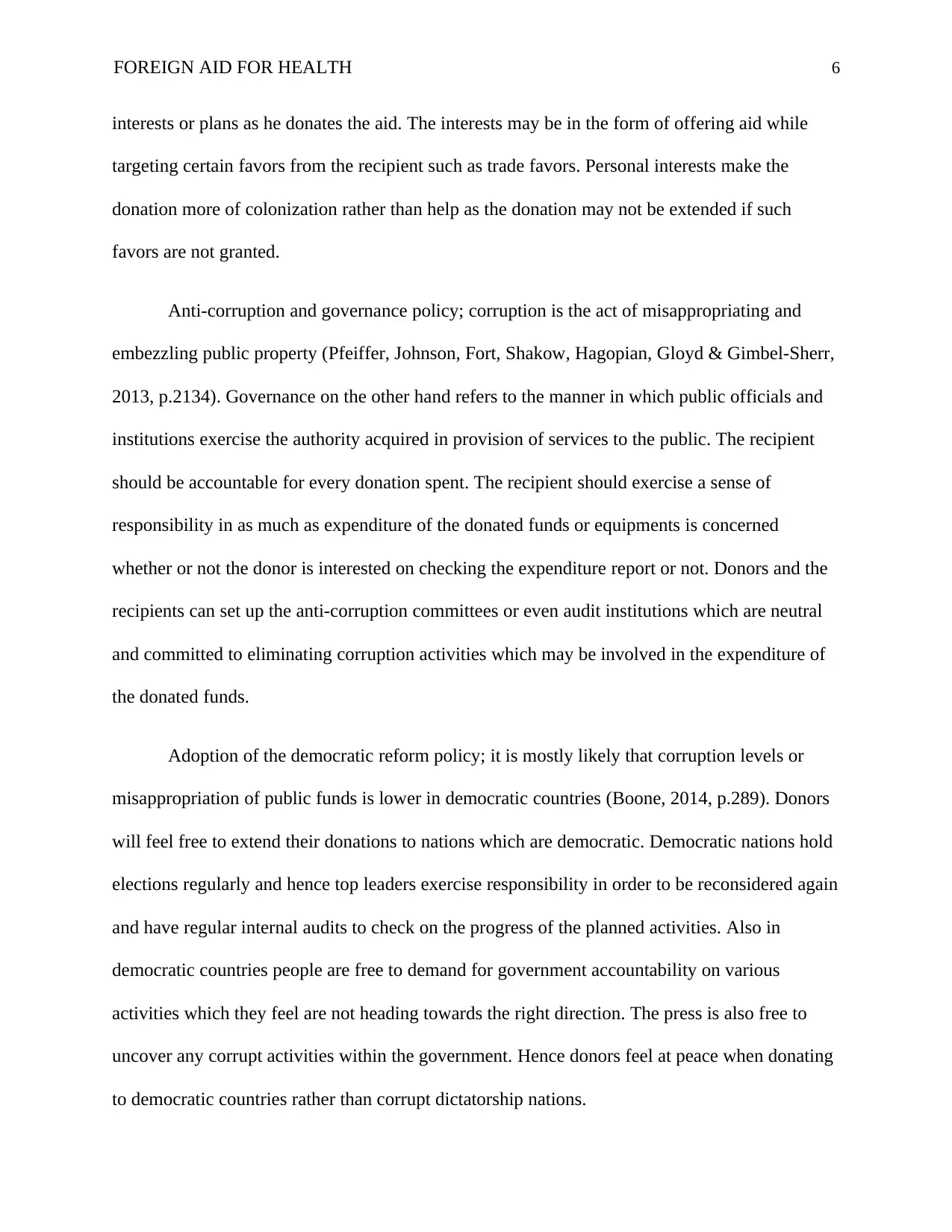
FOREIGN AID FOR HEALTH 6
interests or plans as he donates the aid. The interests may be in the form of offering aid while
targeting certain favors from the recipient such as trade favors. Personal interests make the
donation more of colonization rather than help as the donation may not be extended if such
favors are not granted.
Anti-corruption and governance policy; corruption is the act of misappropriating and
embezzling public property (Pfeiffer, Johnson, Fort, Shakow, Hagopian, Gloyd & Gimbel-Sherr,
2013, p.2134). Governance on the other hand refers to the manner in which public officials and
institutions exercise the authority acquired in provision of services to the public. The recipient
should be accountable for every donation spent. The recipient should exercise a sense of
responsibility in as much as expenditure of the donated funds or equipments is concerned
whether or not the donor is interested on checking the expenditure report or not. Donors and the
recipients can set up the anti-corruption committees or even audit institutions which are neutral
and committed to eliminating corruption activities which may be involved in the expenditure of
the donated funds.
Adoption of the democratic reform policy; it is mostly likely that corruption levels or
misappropriation of public funds is lower in democratic countries (Boone, 2014, p.289). Donors
will feel free to extend their donations to nations which are democratic. Democratic nations hold
elections regularly and hence top leaders exercise responsibility in order to be reconsidered again
and have regular internal audits to check on the progress of the planned activities. Also in
democratic countries people are free to demand for government accountability on various
activities which they feel are not heading towards the right direction. The press is also free to
uncover any corrupt activities within the government. Hence donors feel at peace when donating
to democratic countries rather than corrupt dictatorship nations.
interests or plans as he donates the aid. The interests may be in the form of offering aid while
targeting certain favors from the recipient such as trade favors. Personal interests make the
donation more of colonization rather than help as the donation may not be extended if such
favors are not granted.
Anti-corruption and governance policy; corruption is the act of misappropriating and
embezzling public property (Pfeiffer, Johnson, Fort, Shakow, Hagopian, Gloyd & Gimbel-Sherr,
2013, p.2134). Governance on the other hand refers to the manner in which public officials and
institutions exercise the authority acquired in provision of services to the public. The recipient
should be accountable for every donation spent. The recipient should exercise a sense of
responsibility in as much as expenditure of the donated funds or equipments is concerned
whether or not the donor is interested on checking the expenditure report or not. Donors and the
recipients can set up the anti-corruption committees or even audit institutions which are neutral
and committed to eliminating corruption activities which may be involved in the expenditure of
the donated funds.
Adoption of the democratic reform policy; it is mostly likely that corruption levels or
misappropriation of public funds is lower in democratic countries (Boone, 2014, p.289). Donors
will feel free to extend their donations to nations which are democratic. Democratic nations hold
elections regularly and hence top leaders exercise responsibility in order to be reconsidered again
and have regular internal audits to check on the progress of the planned activities. Also in
democratic countries people are free to demand for government accountability on various
activities which they feel are not heading towards the right direction. The press is also free to
uncover any corrupt activities within the government. Hence donors feel at peace when donating
to democratic countries rather than corrupt dictatorship nations.
⊘ This is a preview!⊘
Do you want full access?
Subscribe today to unlock all pages.

Trusted by 1+ million students worldwide
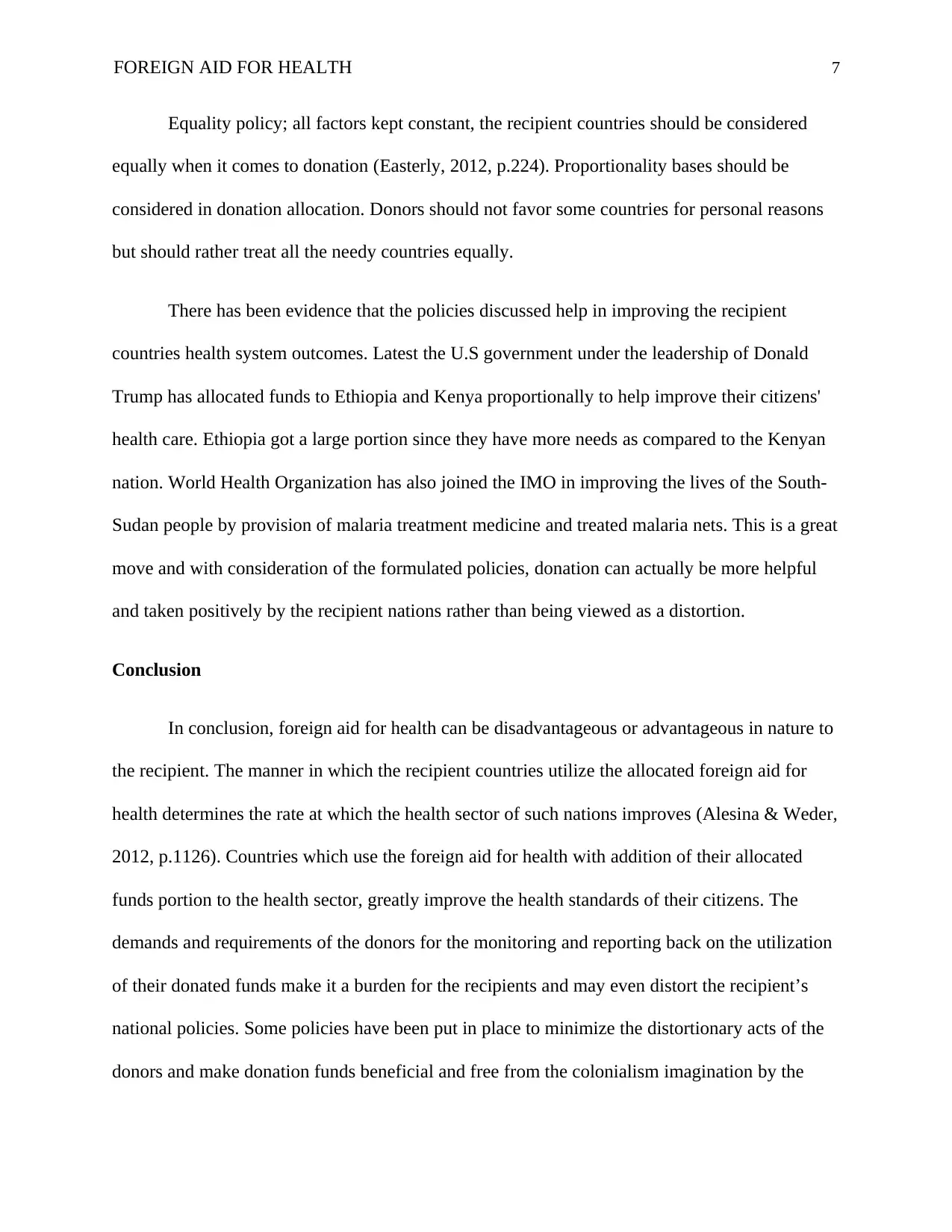
FOREIGN AID FOR HEALTH 7
Equality policy; all factors kept constant, the recipient countries should be considered
equally when it comes to donation (Easterly, 2012, p.224). Proportionality bases should be
considered in donation allocation. Donors should not favor some countries for personal reasons
but should rather treat all the needy countries equally.
There has been evidence that the policies discussed help in improving the recipient
countries health system outcomes. Latest the U.S government under the leadership of Donald
Trump has allocated funds to Ethiopia and Kenya proportionally to help improve their citizens'
health care. Ethiopia got a large portion since they have more needs as compared to the Kenyan
nation. World Health Organization has also joined the IMO in improving the lives of the South-
Sudan people by provision of malaria treatment medicine and treated malaria nets. This is a great
move and with consideration of the formulated policies, donation can actually be more helpful
and taken positively by the recipient nations rather than being viewed as a distortion.
Conclusion
In conclusion, foreign aid for health can be disadvantageous or advantageous in nature to
the recipient. The manner in which the recipient countries utilize the allocated foreign aid for
health determines the rate at which the health sector of such nations improves (Alesina & Weder,
2012, p.1126). Countries which use the foreign aid for health with addition of their allocated
funds portion to the health sector, greatly improve the health standards of their citizens. The
demands and requirements of the donors for the monitoring and reporting back on the utilization
of their donated funds make it a burden for the recipients and may even distort the recipient’s
national policies. Some policies have been put in place to minimize the distortionary acts of the
donors and make donation funds beneficial and free from the colonialism imagination by the
Equality policy; all factors kept constant, the recipient countries should be considered
equally when it comes to donation (Easterly, 2012, p.224). Proportionality bases should be
considered in donation allocation. Donors should not favor some countries for personal reasons
but should rather treat all the needy countries equally.
There has been evidence that the policies discussed help in improving the recipient
countries health system outcomes. Latest the U.S government under the leadership of Donald
Trump has allocated funds to Ethiopia and Kenya proportionally to help improve their citizens'
health care. Ethiopia got a large portion since they have more needs as compared to the Kenyan
nation. World Health Organization has also joined the IMO in improving the lives of the South-
Sudan people by provision of malaria treatment medicine and treated malaria nets. This is a great
move and with consideration of the formulated policies, donation can actually be more helpful
and taken positively by the recipient nations rather than being viewed as a distortion.
Conclusion
In conclusion, foreign aid for health can be disadvantageous or advantageous in nature to
the recipient. The manner in which the recipient countries utilize the allocated foreign aid for
health determines the rate at which the health sector of such nations improves (Alesina & Weder,
2012, p.1126). Countries which use the foreign aid for health with addition of their allocated
funds portion to the health sector, greatly improve the health standards of their citizens. The
demands and requirements of the donors for the monitoring and reporting back on the utilization
of their donated funds make it a burden for the recipients and may even distort the recipient’s
national policies. Some policies have been put in place to minimize the distortionary acts of the
donors and make donation funds beneficial and free from the colonialism imagination by the
Paraphrase This Document
Need a fresh take? Get an instant paraphrase of this document with our AI Paraphraser

FOREIGN AID FOR HEALTH 8
recipient countries. Therefore foreign for health can be beneficial or a burden to the recipient
based on the mode of utilization and the requirements of the donors for the monitoring and
reporting back on the utilization of their donated funds.
References
Alesina, A. and Dollar, D., 2010. Who gives foreign aid to whom and why?. Journal of
economic growth, 5(1), pp.33-63.
Alesina, A. and Weder, B., 2012. Do corrupt governments receive less foreign aid?. American
Economic Review, 92(4), pp.1126-1137.
Atwood, J. Brian, M. Peter McPherson, and Andrew Natsios. "Arrested development: making
foreign aid a more effective tool." Foreign Affairs (2011): 123-132.
Bearce, D.H. and Tirone, D.C., 2010. Foreign aid effectiveness and the strategic goals of donor
governments. The Journal of Politics, 72(3), pp.837-851.
Boone, P., 2014. Politics and the effectiveness of foreign aid. European economic review, 40(2),
pp.289-329.
Easterly, W., 2012. The cartel of good intentions: the problem of bureaucracy in foreign aid. The
Journal of Policy Reform, 5(4), pp.223-250.
Knack, S., 2014. Does foreign aid promote democracy?. International Studies Quarterly, 48(1),
pp.251-266.
Pack, H. and Pack, J.R., 2013. Foreign aid and the question of fungibility. The Review of
Economics and statistics, pp.258-265.
recipient countries. Therefore foreign for health can be beneficial or a burden to the recipient
based on the mode of utilization and the requirements of the donors for the monitoring and
reporting back on the utilization of their donated funds.
References
Alesina, A. and Dollar, D., 2010. Who gives foreign aid to whom and why?. Journal of
economic growth, 5(1), pp.33-63.
Alesina, A. and Weder, B., 2012. Do corrupt governments receive less foreign aid?. American
Economic Review, 92(4), pp.1126-1137.
Atwood, J. Brian, M. Peter McPherson, and Andrew Natsios. "Arrested development: making
foreign aid a more effective tool." Foreign Affairs (2011): 123-132.
Bearce, D.H. and Tirone, D.C., 2010. Foreign aid effectiveness and the strategic goals of donor
governments. The Journal of Politics, 72(3), pp.837-851.
Boone, P., 2014. Politics and the effectiveness of foreign aid. European economic review, 40(2),
pp.289-329.
Easterly, W., 2012. The cartel of good intentions: the problem of bureaucracy in foreign aid. The
Journal of Policy Reform, 5(4), pp.223-250.
Knack, S., 2014. Does foreign aid promote democracy?. International Studies Quarterly, 48(1),
pp.251-266.
Pack, H. and Pack, J.R., 2013. Foreign aid and the question of fungibility. The Review of
Economics and statistics, pp.258-265.
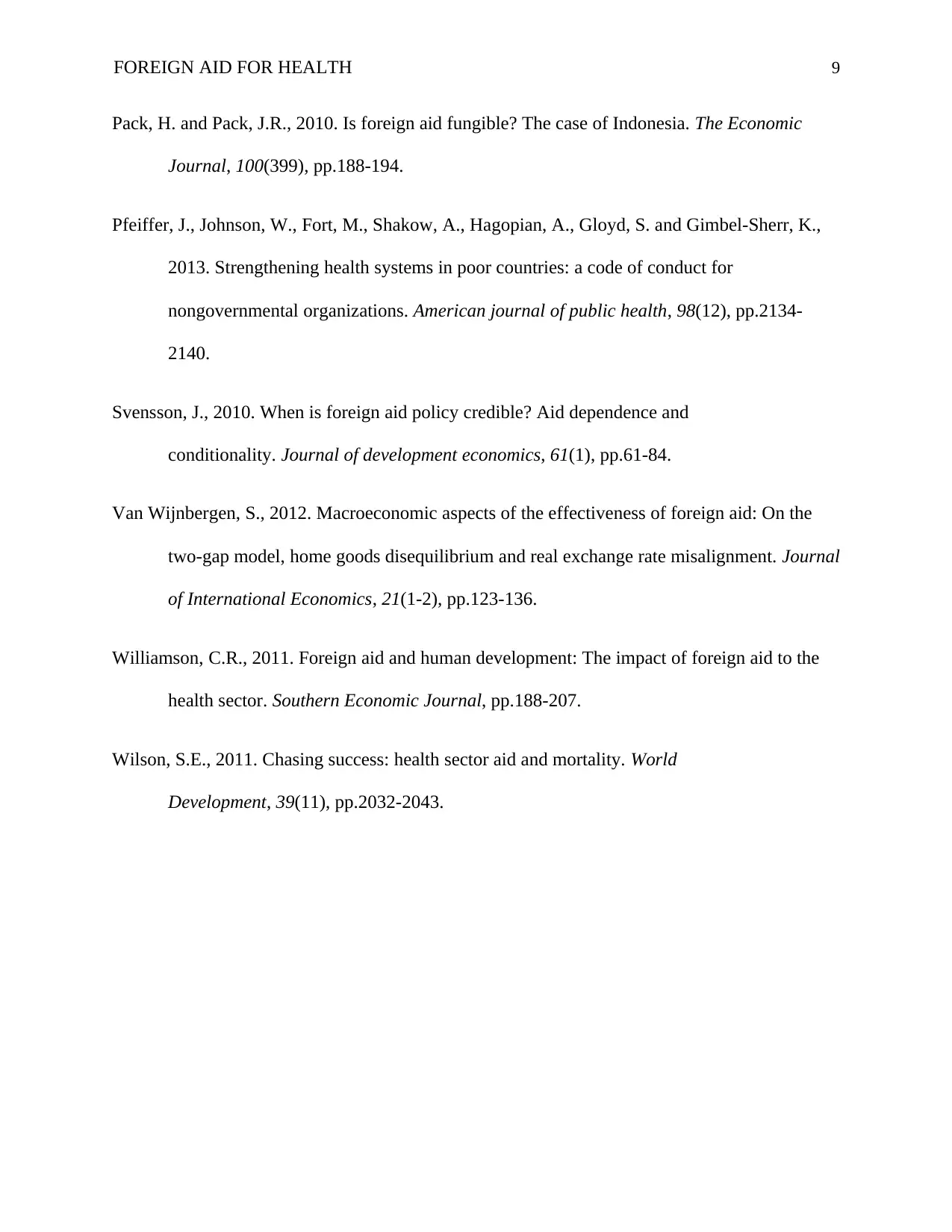
FOREIGN AID FOR HEALTH 9
Pack, H. and Pack, J.R., 2010. Is foreign aid fungible? The case of Indonesia. The Economic
Journal, 100(399), pp.188-194.
Pfeiffer, J., Johnson, W., Fort, M., Shakow, A., Hagopian, A., Gloyd, S. and Gimbel-Sherr, K.,
2013. Strengthening health systems in poor countries: a code of conduct for
nongovernmental organizations. American journal of public health, 98(12), pp.2134-
2140.
Svensson, J., 2010. When is foreign aid policy credible? Aid dependence and
conditionality. Journal of development economics, 61(1), pp.61-84.
Van Wijnbergen, S., 2012. Macroeconomic aspects of the effectiveness of foreign aid: On the
two-gap model, home goods disequilibrium and real exchange rate misalignment. Journal
of International Economics, 21(1-2), pp.123-136.
Williamson, C.R., 2011. Foreign aid and human development: The impact of foreign aid to the
health sector. Southern Economic Journal, pp.188-207.
Wilson, S.E., 2011. Chasing success: health sector aid and mortality. World
Development, 39(11), pp.2032-2043.
Pack, H. and Pack, J.R., 2010. Is foreign aid fungible? The case of Indonesia. The Economic
Journal, 100(399), pp.188-194.
Pfeiffer, J., Johnson, W., Fort, M., Shakow, A., Hagopian, A., Gloyd, S. and Gimbel-Sherr, K.,
2013. Strengthening health systems in poor countries: a code of conduct for
nongovernmental organizations. American journal of public health, 98(12), pp.2134-
2140.
Svensson, J., 2010. When is foreign aid policy credible? Aid dependence and
conditionality. Journal of development economics, 61(1), pp.61-84.
Van Wijnbergen, S., 2012. Macroeconomic aspects of the effectiveness of foreign aid: On the
two-gap model, home goods disequilibrium and real exchange rate misalignment. Journal
of International Economics, 21(1-2), pp.123-136.
Williamson, C.R., 2011. Foreign aid and human development: The impact of foreign aid to the
health sector. Southern Economic Journal, pp.188-207.
Wilson, S.E., 2011. Chasing success: health sector aid and mortality. World
Development, 39(11), pp.2032-2043.
⊘ This is a preview!⊘
Do you want full access?
Subscribe today to unlock all pages.

Trusted by 1+ million students worldwide
1 out of 9
Related Documents
Your All-in-One AI-Powered Toolkit for Academic Success.
+13062052269
info@desklib.com
Available 24*7 on WhatsApp / Email
![[object Object]](/_next/static/media/star-bottom.7253800d.svg)
Unlock your academic potential
Copyright © 2020–2025 A2Z Services. All Rights Reserved. Developed and managed by ZUCOL.





